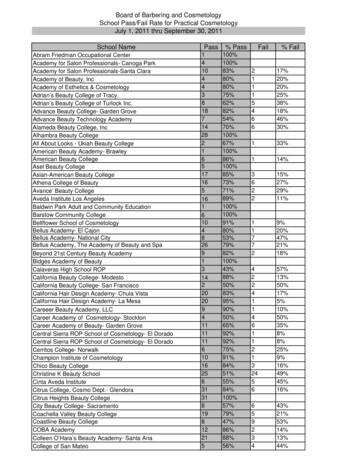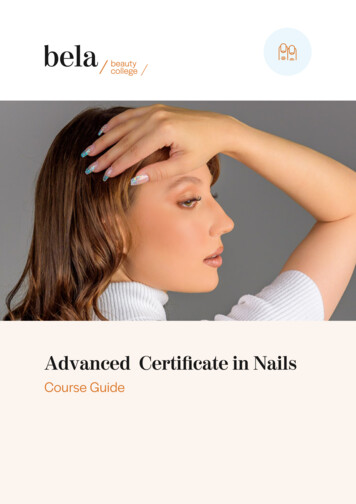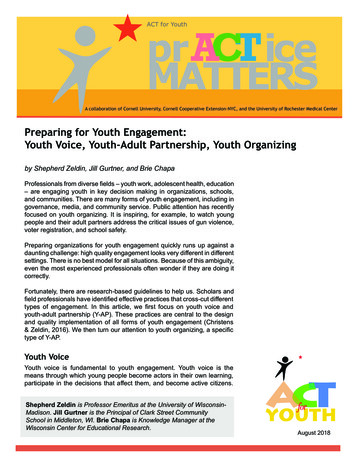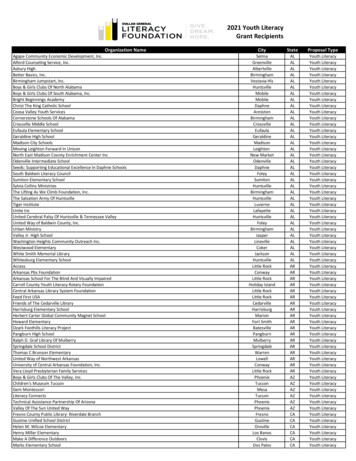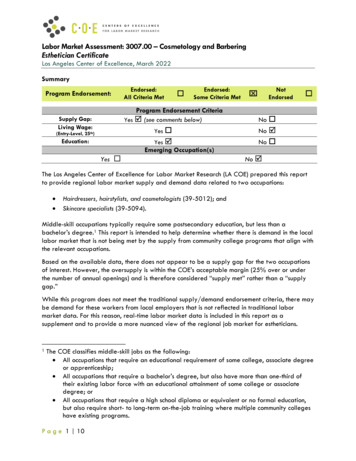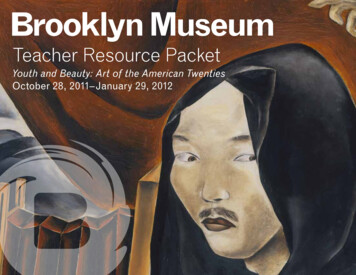
Transcription
Teacher Resource PacketYouth and Beauty: Art of the American TwentiesOctober 28, 2011–January 29, 2012
About the Artist“Art is universal because peopleare universal. The stuff from whichart is made, feeling, intuition andimagination, is part of all peopleeverywhere.”—Yasuo Kuniyoshi 1Youth and BeautyArt of the American TwentiesAbout the ExhibitionYouth and Beauty: Art of the American Twenties explores how painters,sculptors, and photographers described their changing world in the yearsbetween the end of World War I and the onset of the Great Depression.Throughout the twenties, many artists created images of liberated modernbodies and the changing urban-industrial environment with an eye towardideal form and ordered clarity—qualities seemingly at odds with a riotousdecade best remembered for its flappers and Ford Model Ts. Americanartists of the Jazz Age struggled to express the experience of a dramaticallyremade modern world, demonstrating their faith in the potential of youth andin the sustaining value of beauty. This exhibition presents 138 works by artistsincluding Thomas Hart Benton, Imogen Cunningham, Charles Demuth, AaronDouglas, Edward Hopper, Gaston Lachaise, Luigi Lucioni, Gerald Murphy,Georgia O’Keeffe, Alfred Stieglitz, Edward Weston, and, featured in thispacket, Yasuo Kuniyoshi.Yasuo Kuniyoshi was bornin Okayama, Japan, in 1889.Possessing an adventurous spirit,he decided at age thirteen that hewanted to either join the militaryor live in the United States. Hisfather consented to the latter, andat age seventeen, Kuniyoshi arrivedalone in Seattle, Washington, withonly a few words of English anda small sum of money. He began working in a railroad yard and enrolled ina public school, where a teacher noticed his drawing skills and encouragedhim to become an artist. Although he had never considered a career as anartist before, Kuniyoshi decided to enroll in art school in Los Angeles, wherehe discovered his passion for painting. In 1910 he moved to New York City,where he found a community of artists, attended several art schools, andvisited museums for the first time in his life. He began exhibiting his work ingroup and solo shows, eventually establishing himself as a renowned artist inthe United States and Japan. Kuniyoshi became a venerated educator at theArt Students League and the New School for Social Research, and servedas the first president of the Artists Equity Association from 1947 to 1950.He participated in many social organizations, especially Japanese Americanones, such as the Japanese American Committee for Democracy. He alsocontributed to the war effort during World War II, designing posters for theOffice of War Information, although he was not allowed to participate incertain activities because he was not an American citizen. While Kuniyoshiconsidered himself an American artist, he highly valued his Japaneseheritage. According to a statement he made in the Magazine of Art in March1940, his artistic aim was “to combine the rich traditions of the East with myaccumulative experiences and viewpoint of the West.”Donald B. Goodall, introduction to Yasuo Kuniyoshi, 1889–1953: A Retrospective Exhibition, exh.cat. (Austin: University Art Museum, University of Texas, 1975), 18.1
Description of Self-Portrait as aPhotographer, 1924In the foreground of the painting, apale young man with a trim mustachewearing a white, cuffed shirt stands withhis back to the viewer. His upper bodyfills the right side of the composition. Helooks downward over his left shoulder.His head is draped with a black cloth that falls to his shoulders. The man’s rightarm is raised above his head to hold back a swath of red drapery. Revealedbehind the drapes is a sparse black-and-white landscape with a single, baretree, undulating hills, and a cloudy sky. The fingers of his left hand curl aroundthe shutter button of a folding camera with an accordion bellows (the pleatedexpandable part of a camera), which is aimed toward the barren landscape.About the ArtworkAt the time this painting was completed in 1924, Kuniyoshi was supportinghimself and his wife by accepting photographic commissions from othermembers of the New York art world. Artists and galleries hired him to photograph studio spaces and the artwork made there. Self-Portrait as a Photographer shows the artist at work, and the painting creates a modernist,dreamlike ambiguity of meaning often found in his art. For example, Kuniyoshishows himself using a dark focusing cloth, which covers the back of thecamera and the photographer’s head in order to prevent environmental lightfrom obscuring the image in the viewfinder. His shrouded head might be readas a metaphor for revealing or hiding identity. Also open to several possibleinterpretations is the black-and-white landscape, which appears to be theartist’s photographic subject. The light brown line running along the bottomof the landscape might indicate the wooden frame of a window, or that of apainting. It is unclear whether the bare tree, hills, and cloudy sky present ablack-and-white interpretation of what Kuniyoshi observed outside his ownstudio (he often worked in rural areas) or whether they represent an artwork heis photographing on commission from a fellow artist. Finally, the position of thecamera is ambiguous: is it resting on the windowsill or on an unseen support?Kuniyoshi and other modern artists experimented with new ways of seeingand with fresh ideas about the nature of materials and the purpose of art.Self-Portrait as a Photographer includes several stylistic choices that arecommon to traditional Japanese woodblock prints (whose pictorial qualitiesinfluenced many modernists), as well as techniques used in Western painting(see “East Meets West” activity).Questions for LookingWhat’s going on in this painting?What do you notice about the figure’s pose and facial expression? Whatinformation might these details convey about this person?Look closely at the objects the figure is holding and wearing. What mightthese objects tell us about this person?This painting is a self-portrait. What aspects of his identity did theartist Yasuo Kuniyoshi choose to include here? What do you think theycommunicate about him?Kuniyoshi often painted from a combination of direct observation, memory,and his imagination. What do you see that he might have observed aroundhim? What might have been painted from memory? What might have comefrom his imagination? Support your answer with details you find in the painting.This painting has several visual elements that can be interpreted in differentways. Look closely at the black-and-white landscape. Do you think this is apainting or the view from the window? What do you see to support your idea?Do other areas of the painting seem ambiguous (having several possiblemeanings) to you? Why?ActivitiesEast Meets WestKuniyoshi said that his goal as an artist was “to combine the rich traditionsof the East with [his] accumulative experiences and viewpoint of the West.”To better understand how Kuniyoshi brought these traditions together in hiswork, compare the painting River Scene, by Charles-François Daubigny, anda print from Japanese artist Utagawa Hiroshige's Sixty-nine Stations on theKisokaido Highway (reproduced in this packet). These works demonstratehow the same principles of art were employed differently by two artistsworking in art-making traditions from the West and East, respectively.Begin by defining these four key vocabulary words: perspective, shading,color, and composition (use the chart on the next page as a reference). Workwith a partner or in a small group to look carefully at the two artworks forevidence of these principles of art. Record your observations. Share anddiscuss your findings.Look closely at Kuniyoshi’s Self-Portrait as a Photographer. What characteristicscan you find from each artistic tradition? In what ways does he break fromboth traditions? Do you think Kuniyoshi achieved his goal of combining theEast and West?
Japanese WoodblockPrintsTraditional WesternPaintingPerspectiveA technique usedto suggest threedimensional formson a two-dimensionalsurfaceFlattened perspective,where space appears tobe fairly shallowLinear perspective,where space appearsto recede far into thedistanceShadingThe shading of areas togive a sense of formLimited use of shadingHigh degree of shadingSelf-Portrait as . . .In the painting Self-Portrait as a Photographer, Kuniyoshi emphasized hisartistic practice as an important part of his identity. Three years later,he painted himself in another role, in Self-Portrait as a Golf Player, 1927(Museum of Modern Art, New York). Since the beginning of modernism in thenineteenth century, many artists, including Kuniyoshi, have experimented withways of presenting their identities to the public. Find self-portraits by otherartists (your school art teacher and librarian can help), and look closely to seewhat aspects of their identities they chose to emphasize. Suggested artistsinclude Frida Kahlo, Andy Warhol, and Yasumasa Morimura. Create two selfportraits of your own that explore two different aspects of your identity. Youmay choose to use mixed media, photography, collage, painting, drawing, orany other medium that works best for you. You can further experiment withyour artwork by combining your two portraits in a single work, as in FridaKahlo’s The Two Fridas, 1939 (Museo de Arte Moderno, Mexico City).ResourcesColorAn element of art withthree properties: hue(the color name; e.g.,red); intensity (a color’sstrength; e.g., brightor dull red); and value(a color’s lightness ordarkness)Flat, outlined blocks ofsolid colorCompositionThe plan, placement,or arrangement of visualelements in a workOff-center placementof the subjectBlended colorsCarbone, Teresa A. Youth and Beauty: Art of the American Twenties. Exh. cat.New York: Brooklyn Museum and Skira Rizzoli, 2011.This catalogue to the exhibition Youth and Beauty: Art of the AmericanTwenties, organized by the Brooklyn Museum, features color images of worksfrom the exhibition and essays by Teresa A. Carbone, Bonnie Costello,Randall R. Griffey, and Sarah M. Lowe.http://www.discovernikkei.org/enThis website is devoted to stories and pictures of Japanese immigrants andtheir descendants.Centrally positionedsubjectExtension ActivityChiura Obata, Isamu Noguchi, Miné Okubo, Hiromu Kira, and BumpeiUsui were all contemporaries of Kuniyoshi’s as well as fellow JapaneseAmericans (works by Noguchi, Kira, and Usui are also included in theexhibition). Research these artists to learn more about their artwork.Discover some of the different ways they chose to combine Eastern andWestern artistic traditions.Meyers, Jane, and Tom Wolf. The Shores of a Dream: Yasuo Kuniyoshi’s EarlyWork in America. Exh. cat. Fort Worth: Amon Carter Museum, 1996.This catalogue features color plates of many of Kuniyoshi’s paintings anddrawings from the twenties and essays exploring the artist’s early landscapes/humansandnature.cfmThe Nelson-Atkins’s website for the 2011–12 exhibition Landscapes East /Landscapes West: Representing Nature from Mount Fuji to Canyon de Chellyjuxtaposes landscape paintings, drawings, prints, and photographs byChinese, Japanese, European, and American artists from the fifteenthcentury to the present.
wamericans.htmlThe New Americans website offers an interactive online resource for 7thto 12th-grade students. The site supplements the PBS Independent Lensdocumentary mini-series, which explores the immigrant experience throughthe personal stories of immigrants to the United States. The site alsoincludes lesson plans for educators.Riehlman, Franklin, Tom Wolf, and Bruce Weber, Yasuo Kuniyoshi: Artistas Photographer. Exh. cat. Annandale-on-Hudson, N.Y.: Edith C. Blum ArtInstitute, Milton and Sally Avery Arts Center, Bard College Center, with theNorton Gallery and School of Art, 1983.This catalogue examines Kuniyoshi as a photographer and the relationshipbetween his paintings and his photographic work.This packet was written by Nicola Giardina and Rachel Ropeik, Senior MuseumEducators, with assistance from Alexa Fairchild, School Programs Manager,and Teresa A. Carbone, Andrew W. Mellon Curator of American Art.Cover (detail), pages 3,6: Yasuo Kuniyoshi (American, 1889–1953). Self-Portrait as a Photographer, 1924. Oil oncanvas, 20⅜ x 30¼ in. (51.8 x 76.8 cm). The Metropolitan Museum of Art, New York, Bequest of Scofield Thayer,1982 (1984.433.11). Estate of Yasuo Kuniyoshi / Licensed by VAGA, New York, NY. Photo: The MetropolitanMuseum of Art / Art Resource, NYPage 2: Peter A. Juley & Son. Yasuo Kuniyoshi seated in front of "Room 110." Photograph. Peter A. Juley & SonCollection, Photograph Archives, Smithsonian American Art Museum, Washington, D.C.The exhibition was organized by Teresa A. Carbone, Andrew W. Mellon Curator ofAmerican Art at the Brooklyn Museum.Sponsored byYouth and Beauty: Art of the American Twenties is also made possible by the HenryLuce Foundation. Additional support has been provided by the Martha A. and Robert S.Rubin Exhibition Fund, The Mr. and Mrs. Raymond J. Horowitz Foundation for the Arts,the National Endowment for the Arts, the Wyeth Foundation for American Art, theSteven A. and Alexandra M. Cohen Foundation, Inc., Sotheby’s, the Norman M.Feinberg Exhibition Fund, and an anonymous donor. This exhibition is supported by anindemnity from the Federal Council on the Arts and the Humanities.The accompanying catalogue is supported by the Henry Luce Foundation, the NationalEndowment for the Arts, The Mr. and Mrs. Raymond J. Horowitz Foundation for theArts, Furthermore: a program of the J. M. Kaplan Fund, and a Brooklyn Museum publications endowment established by the Iris and B. Gerald Cantor Foundation and theAndrew W. Mellon Foundation.Pages 4,7: Utagawa Hiroshige (Ando) (Japanese, 1797–1858). Ashida, from Sixty-nine Stations on the Kisokaido Highway (Kisokaido Rokuju-Ku Tsugi), circa 1838. Woodblock color print, 8 15/16 x 13 15/16 in. (22.6 x 35.4 cm). BrooklynMuseum, Frank L. Babbott Fund, 39.576Pages 4,8: Charles-François Daubigny (French, 1817–1878). River Scene, 1859. Oil on panel, 14¼ x 25¾ in. (36.2 x65.4 cm). Brooklyn Museum, Bequest of William H. Herriman, 21.134is print media sponsor.
Carbone, Teresa A. Youth and Beauty: Art of the American Twenties. Exh. cat. New York: Brooklyn Museum and Skira Rizzoli, 2011. This catalogue to the exhibition Youth and Beauty: Art of the American Twenties, organized by the Brooklyn Museum, features color images of works from the exhibition and essays by Teresa A. Carbone, Bonnie Costello,

